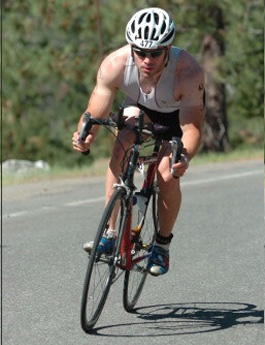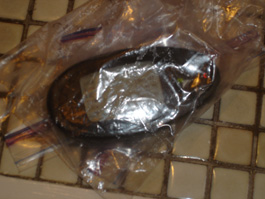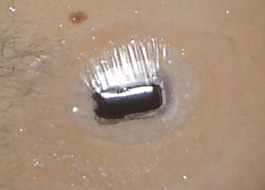
Flying
down Donner Pass. |
4/12/06:
Overnight Low Prevention
Racing
season is right around the corner and my first event, the
100 mile ADA Tour de Cure in Napa, is in 4 short weeks. To
prepare, I've been increasing the duration and intensity of
my workouts which has significantly increased my insulin sensitivity
and affected my diabetes management. So far, Dexcom has helped
me manage these changes.
As I mentioned
before, one of the toughest challenges with exercise and diabetes
is the post-exercise hypoglycemia. Learning from my previous
overnight low experience with Dexcom, I set the receiver's
low threshold to 90. Over the next few days, I took my bike
for two long rides. The nights following those intense workouts,
Dexcom woke and warned me of the overnight low before it was
too late. "Too late" means waking up shaky, sweaty,
starving, etc. Thanks to Dexcom, I was able to correct with
a few glucose tabs and then go back to bed. The mornings following
those two nights, I woke up with BG's in the 100's. This is
makes the expense of the Dexcom worthwhile to me.
Since
writing my story, I've been asked many questions about existing
and future continuous glucose sensors. I started to create
a spreadsheet that compared these sensors, but then discovered
the work had already been done. For comparison info on continuous
glucose sensors, please visit:
www.childrenwithdiabetes.com/continuous.htm.
I was
surprised, excited, and honored to see My New Friend Dexcom
listed as a web site for "more info" on sensors.
Thank you CWD.
Dexcom
and I are preparing to hit the ski slopes of Lake Tahoe. I'm
sure we'll have some exciting stories to share.
Regards,
Matt
I do
not work for nor am I compensated by Dexcom in any way. I'm
writing this story because I think continuous glucose technology
is interesting and exciting. Also, I am not a health care
professional and do not give medical advice. I will share
my experiences, but please check with your health care team
before making any changes to your diabetes or health management.
|
|

The next Gary Hall Junior?

Double Ziploc bagged receiver.

Shower patch with IV Prep.
|
4/10/06:
Swimming with Dexcom
I believe
it's better to manage diabetes around your life, rather than
allowing diabetes to take control. Swimming, biking, and running
are a few of the things I enjoy doing in my free time. My
friend Dexcom and I had already tried biking and running,
so I thought it was time we took our first swim together.
Surprisingly, we both had a great time.
I arrived
at my local indoor pool, put on my swim suit, cap, and goggles
and then spent some time preparing Dexcom for the water. The
sensor is not waterproof, so first I put down a sticky/tacky
layer around the sensor with an IV Prep pad. I then covered
the sensor with a shower patch and carefully sealed the pad's
edges. The range of the receiver is about 5 feet, much too
short to get readings at the other end of the pool, 75 feet
away. So, in order to see my BG values while swimming, I had
a few options:
1. Pay
someone to walk along the pool deck following me within five
feet lap after lap. This seemed expensive and not very realistic.
2. Attach the receiver to a floating buoy and pull it while
I swim. "Where am I going to find a mini-buoy?"
I thought to myself.
3. Tuck the receiver into my swim suit, next to my insulin
pump. Risky, but probably the best choice for me.
Even though
the receiver is water resistant, it's not made to be submerged
under water. I double bagged the receiver with heavy duty
Ziploc freezer bags and carefully sealed each bag. The bags
were clear, so I could easily see the receiver's screen. The
entire Dexcom waterproofing process took about 30 minutes.
I jumped
in the pool, swam a few laps, and then inspected the receiver
bags and shower patch. Everything looked watertight, so I
continued my pool workout. The sensor was comfortable to wear
in the pool, the receiver felt a little bulky in my shorts
and probably created some drag, but overall Dexcom didn't
interfere with my stroke. I constantly checked the sensor
and receiver's status looking for any indication of leaks
and monitored my glucose levels. After 60 minutes of freestyle,
breaststroke, kickboard, and flip turns, Dexcom's first swimming
lesson was over.
I was
extremely happy that the swim test was successful and the
shower patch and Ziploc bags kept the water out. According
to the receiver, I started swimming with a 174 and steadily
dropped down to 126. According to the data, it seems my diabetes
management routine for swimming works well. I rarely swim
for over an hour, but if I ever need to go longer, a few sips
of Gatorade or a packet of energy gel should help maintain
my BG levels. Back in the locker room, a finger poke revealed
a 135 value which was very close to Dexcom's reading. Although
it was interesting to see my BG's, my paranoia that water
may be shorting out the system didn't really make the experience
worthwhile.
Dexcom
does not recommend taking the STS Continuous Glucose Monitoring
System to the pool, lake, ocean, or water park. Any such action
that results in a malfunction of the system is not covered
under the manufacturer's warranty. I took a $500 risk swimming
with Dexcom, I probably won't do it again, and I don't recommend
you do it either.
After
a shave and shower, I put on my best formal wear in preparation
for the Sacramento JDRF Gala. At the event, I took great pleasure
showing off Dexcom to both old friends and new acquaintances.
Just before dinner, I started to feel a little lightheaded
and just then Dexcom vibrated and gave me a "LOW"
BG alert. A finger stick reading of 69 confirmed the alert,
I ordered an OJ from the bar, and headed towards my table.
"I really owe one to my friend Dexcom for spotting that
low," I thought to myself. The gala was amazing and thanks
to the hard work of Judy Fern (executive director), staff,
board members, volunteers, and gala attendees, over $240,000
was raised for the JDRF!
Just before
bed, Dexcom said 210 and a finger stick read 205. I gave a
correction bolus for the 205 and went to sleep. At 2:14 am,
I woke feeling shaky and extremely hungry. It felt like a
low, but I thought I should check to make sure. I pushed Dexcom's
buttons and the backlit display read 81 with a flat trending
graph for the past hour. An Ultra finger stick test read 45,
which seemed more realistic. I stumbled to the kitchen, drank
a Gatorade (40 grams of carbohydrate), and ate a granola bar
(25 gm carbs). I found my bed and fell back asleep. A few
minutes later, I was woken up by Dexcom vibrating, beeping,
and flashing a "LOW 55" alert. Another Ultra test
gave me a 95 reading. Dexcom was a little late, due to the
interstitial fluid lag time. The food was obviously working,
but the granola bar was probably too much, so I bolused 1.65u
of insulin to cover the extra carbs, and slept for the rest
of the night.
The next
morning I woke feeling a little groggy. Dexcom read 315, which
I found very hard to believe. A finger stick was a pretty
close reading 283, so I went to Dexcom's 9 hour graph to find
out what happened. My BG had been steady, around the mid-80
range, for about an hour until 2:00'ish when it dropped below
55 for two readings, then skyrocketed to the high 300's within
30-60 minutes. My BG had pretty much stayed in the 300's until
I woke.
With this
retrospective data, I was able to confidently form a theory
to explain the overnight BG phenomenon. Due to the day's increased
exercise (swimming), my muscles were low on glycogen, and
at 2:00am my body replenished the glycogen stores with the
glucose in my blood. Since my BG was around 80, the glycogen
replenishment caused sever hypoglycemia. My body sensed the
low, woke me up, and told my liver to take counter-regulatory
measures (dump your glucose stores now). The 40 grams of carbs
I ate pushed my BG up even further and my liver secreted insulin
resistance causing hormones, so my BG stayed high. This is
just a theory, so if you have some expertise on the subject,
I welcome your insight.
It would
have been nice if Dexcom had warned me of the low BG before
I woke up, but the reality of interstitial fluid's time lag
made it impossible for this system to react in time. My solution
for next time: The night after a moderately intense workout,
I will set Dexcom's low BG threshold to 90 or 100. This way,
I can play it safe with a slightly higher BG and help prevent
the 2:00am glycogen replenishment from causing another hypoglycemic
reaction.
Post-exercise
overnight lows are extremely scary, frustrating, and potentially
dangerous. Thankfully, I wake up if I'm low in the middle
of the night. I usually wake up sweaty and shaky, feeling
like I could die if I don't have something to eat right away.
All I really need to correct the hypoglycemia is 15 to 45
grams of carbs. However, since it takes 15 to 20 minutes for
my brain to tell me I'm alright, I typically empty the fridge
of all its sweet treats, which is 3 to 5 times more carbs
than I really need. I then wake up the next morning with an
extremely high blood glucose value. After a night like that,
I will be so insulin resistant that my BG's will be high and
I'll feel sick for most of the next day.
Although
I wasn't happy about my BG's being in the 300's for most of
the night, I felt empowered, thanks to Dexcom, to know what
happened while I was sleeping and have a plan to prevent this
from happening again.
So far
I've realized that collecting data, analyzing results, writing
the story, and publishing my finished blog takes a significant
amount of time of energy. In order to maintain my real job,
personal relationships, exercise routine, and overall sanity,
I will do my best to have fresh content for you at least once
a week, maybe twice (Monday and Thursday). Thank you very
much for your comments, questions, and stories. I look forward
to writing again soon.
Take care,
Matt
I do
not work for nor am I compensated by Dexcom in any way. I'm
writing this story because I think continuous glucose technology
is interesting and exciting. Also, I am not a health care
professional and do not give medical advice. I will share
my experiences, but please check with your health care team
before making any changes to your diabetes or health management.
|



